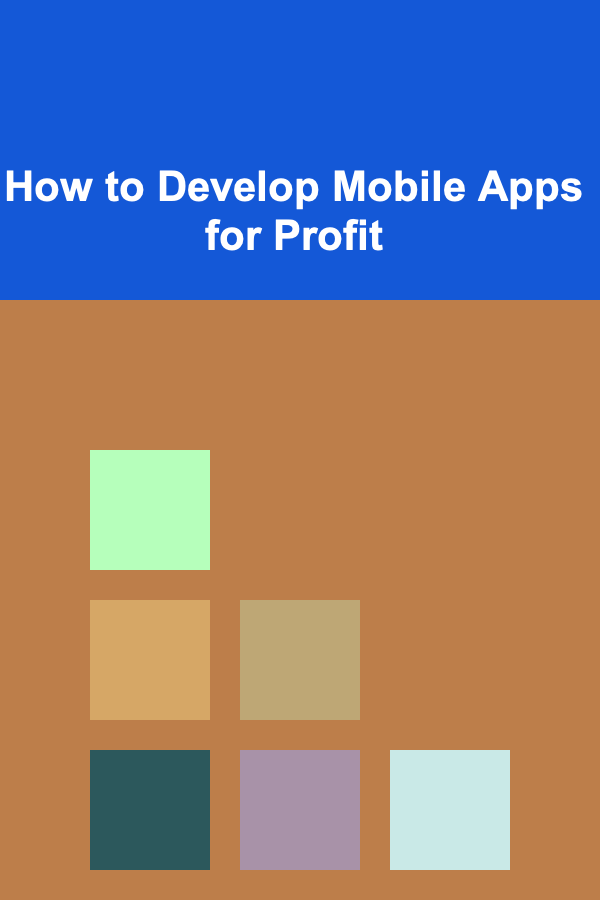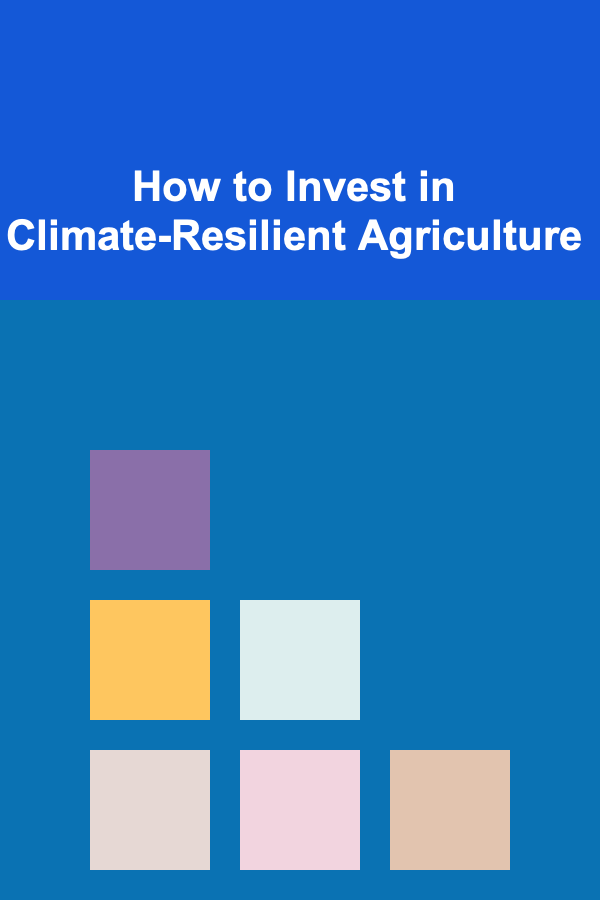
How to Develop Mobile Apps for Profit
ebook include PDF & Audio bundle (Micro Guide)
$12.99$8.99
Limited Time Offer! Order within the next:

The world of mobile apps has exploded over the past decade. With billions of smartphone users globally, the mobile app market has become a thriving ecosystem. Whether it's a gaming app, productivity tool, or health tracker, mobile applications have permeated every aspect of daily life, creating immense opportunities for developers to create apps that generate significant revenue.
In this article, we will explore how to develop mobile apps for profit. From identifying the right idea and market to monetization strategies and marketing, we will break down the entire process to help you turn your app development skills into a profitable business.
Understanding the Mobile App Market
Before diving into development, it's important to understand the mobile app market. Mobile apps can be broadly categorized into several types, each with its own audience and monetization potential:
- Games: Mobile gaming has become one of the largest and most profitable sectors in the mobile app market. Popular games like "Clash of Clans" and "Candy Crush" generate billions in revenue every year.
- Utility Apps: These are apps that improve productivity, enhance communication, or streamline daily tasks. Examples include apps like Evernote, Google Drive, or task managers like Todoist.
- Lifestyle and Health Apps: Apps that track fitness, nutrition, mental health, or provide lifestyle tips are increasingly popular as people focus on health and wellness.
- Entertainment: Streaming services, music apps, and media players fall under this category. Apps like Netflix, Spotify, and YouTube dominate the market.
- Business and Finance: These apps cater to business professionals and individuals managing their finances, such as accounting apps, mobile banking, or trading platforms.
Understanding which category your app will fall into can help you define your target audience and determine the best monetization strategy.
Identifying a Profitable Idea
The key to developing a successful mobile app is identifying a profitable idea. While it's tempting to chase popular trends or try to reinvent the wheel, the most successful apps often solve real problems or offer unique value to users.
Conduct Market Research
To identify a profitable idea, start with market research. Look at the current trends in mobile apps and pay attention to consumer needs. Tools like Google Trends, App Annie, and Sensor Tower can give you insights into app popularity, competition, and emerging niches.
You should also analyze the user reviews of top apps in your chosen category to understand what users like or dislike about existing solutions. By identifying gaps in the market or areas where existing apps are lacking, you can find opportunities for improvement.
Validate Your Idea
Once you have an idea, it's important to validate it before jumping into full development. This can be done through:
- Surveys and Focus Groups: Gather feedback from potential users to understand if your app solves their problem and if they would be willing to pay for it.
- Landing Pages: Create a simple landing page or website explaining the app and its features. Use paid ads to drive traffic to the page and measure the interest.
- Minimum Viable Product (MVP): Build a basic version of your app with just enough features to demonstrate its value. Release it to a small group of users and collect feedback for future improvements.
Planning Your App
Once your idea is validated, it's time to plan the development of your app. Proper planning can save you time and resources, ensuring that the app meets both your and your users' expectations.
Define Features and Functionality
Start by defining the core features of your app. List down all the functionalities that your app must include, and prioritize them based on user needs and business goals. For example, if you are developing a fitness app, core features might include activity tracking, workout plans, and progress charts.
Once you've listed the features, decide on the additional, non-essential features that can be added later. This helps in preventing scope creep during development, where new features are continuously added without proper planning, delaying the app's launch.
User Experience (UX) and User Interface (UI)
User experience (UX) is a critical factor in mobile app development. A well-designed app that is intuitive, easy to use, and visually appealing will have a much higher chance of success. Ensure your app has an efficient layout, smooth navigation, and a design that reflects the app's purpose.
UI design is equally important. Make sure your app's interface is visually engaging and matches the platform's design guidelines. For iOS apps, follow Apple's Human Interface Guidelines, and for Android apps, adhere to Google's Material Design principles.
Set Your Budget and Timeline
App development can be costly and time-consuming. Establishing a realistic budget and timeline is essential. The complexity of your app, the platform you choose (iOS, Android, or both), and whether you will be outsourcing development or handling it yourself will all impact the cost.
Be prepared for unexpected costs, such as marketing, maintenance, and server hosting. It's essential to allocate resources for these as part of your overall plan.
Developing Your App
With the planning in place, the next step is the actual development of the app. Here, you have two main options: developing it yourself or hiring a development team.
4.1 Developing the App Yourself
If you have the technical expertise, you can develop the app yourself. This involves:
-
Choosing the Right Development Framework: There are several options to consider, including:
- Native Development: Using platform-specific programming languages (Swift for iOS, Kotlin for Android).
- Cross-Platform Development: Tools like React Native or Flutter allow you to write code once and deploy it on both iOS and Android.
- Hybrid Development: Frameworks like Ionic allow you to create apps using web technologies that run in a native wrapper.
Choosing the right framework depends on your needs, including performance requirements, budget, and target platforms.
-
Programming and Backend Setup: You will need to write the code for both the front-end (user interface) and back-end (server-side operations) of your app. If your app requires a database or integration with other services (such as payment gateways), you will need to set up a backend system.
-
Testing and Quality Assurance: Testing your app throughout the development process is essential to identify bugs and improve performance. Use tools like TestFlight (iOS) or Firebase Test Lab (Android) to test your app on real devices.
4.2 Hiring a Development Team
If you lack the technical skills or want to focus on other aspects of the business, you can hire a development team. Freelance platforms like Upwork, Toptal, and Fiverr provide access to skilled developers for both short-term and long-term projects. When hiring a team, ensure they have experience in mobile app development and a portfolio of previous work.
Establish a clear communication channel with the development team and maintain regular updates to ensure that the project is on track.
Monetizing Your Mobile App
Once your app is developed and ready to launch, the next step is to figure out how to monetize it. There are several monetization strategies available, depending on the type of app and your target audience.
5.1 In-App Purchases
In-app purchases (IAPs) are one of the most common monetization methods. This involves offering a free app with optional paid features or content. Examples include additional levels in a game, premium features in a utility app, or virtual goods like coins and gems.
- Consumable Purchases: Items that can be used up, such as game currency or temporary boosts.
- Non-consumable Purchases: Items that are permanent, such as unlocking new levels or features.
- Subscriptions: Charging users on a recurring basis for premium content or features.
5.2 Advertisements
Mobile apps can also make money through ads. This is most commonly seen in free apps, where ads are shown to users in exchange for providing the app at no cost. Ad networks such as Google AdMob, Facebook Audience Network, and Unity Ads help developers monetize by showing banner ads, interstitial ads, or rewarded video ads.
While ad revenue can be significant, it's important to ensure that ads do not interfere with the user experience. Too many ads can lead to user frustration and high uninstallation rates.
5.3 Paid Apps
If your app provides enough value or is highly niche, you can sell it as a paid app upfront. Users will need to pay to download the app from the App Store or Google Play Store. However, paid apps often have a lower conversion rate, so the app must offer substantial value to justify the cost.
5.4 Affiliate Marketing and Partnerships
Some apps can earn money through affiliate marketing or partnerships with other businesses. For example, a fitness app can partner with a fitness equipment company and earn a commission for every purchase made through the app.
Similarly, you can integrate affiliate links to products within your app, earning a commission for each sale made through those links.
5.5 Freemium Model
The freemium model combines free access with the option to upgrade to a premium version. This strategy works well for apps that offer both basic and advanced features. The free version attracts users, while the paid version offers more functionality or removes ads.
Marketing Your Mobile App
Building a great app is just one part of the equation. To turn your app into a profitable venture, you need to effectively market it to your target audience.
6.1 App Store Optimization (ASO)
ASO is similar to SEO but for app stores. Optimizing your app's title, description, keywords, and screenshots can help increase its visibility and downloads. Use relevant keywords that users are likely to search for when looking for apps in your category.
6.2 Social Media Marketing
Social media platforms like Facebook, Instagram, Twitter, and LinkedIn are powerful tools for promoting your app. Create a presence for your app on these platforms and engage with users by posting updates, tips, and user-generated content.
6.3 Influencer Marketing
Partnering with influencers in your niche can help you gain credibility and exposure. Reach out to influencers with a strong following in your app's category and offer them a free version of your app in exchange for reviews or mentions.
6.4 Paid Advertising
Paid ads on platforms like Google, Facebook, or Instagram can help drive traffic to your app. Set a clear budget and target specific user demographics to ensure that your ads reach the right audience.
6.5 Public Relations (PR)
Getting featured in media outlets, blogs, and app review sites can help generate buzz around your app. Reach out to journalists and bloggers who cover the mobile app industry and pitch your app to them for reviews.
Conclusion
Developing a mobile app for profit requires a combination of creativity, technical skills, and business acumen. From identifying a profitable idea and designing a user-friendly experience to selecting the right monetization strategy and marketing effectively, every step plays a crucial role in your app's success.
By understanding the market, planning your app carefully, and leveraging the right monetization techniques, you can turn your app development efforts into a profitable business. With persistence, strategic thinking, and the ability to adapt to changing trends, the potential for success in the mobile app market is enormous.

How to Set Up a Meeting Area in Your Home Office
Read More
Smart Financial Planning for College Tuition: Strategies to Reduce Debt
Read More
How to Invest in Climate-Resilient Agriculture
Read More
How to Identify Plot Holes and Inconsistencies
Read More
How To Develop a Yoga Sequence for Detoxification
Read More
Understanding User Experience (UX) Principles for Designers
Read MoreOther Products

How to Set Up a Meeting Area in Your Home Office
Read More
Smart Financial Planning for College Tuition: Strategies to Reduce Debt
Read More
How to Invest in Climate-Resilient Agriculture
Read More
How to Identify Plot Holes and Inconsistencies
Read More
How To Develop a Yoga Sequence for Detoxification
Read More